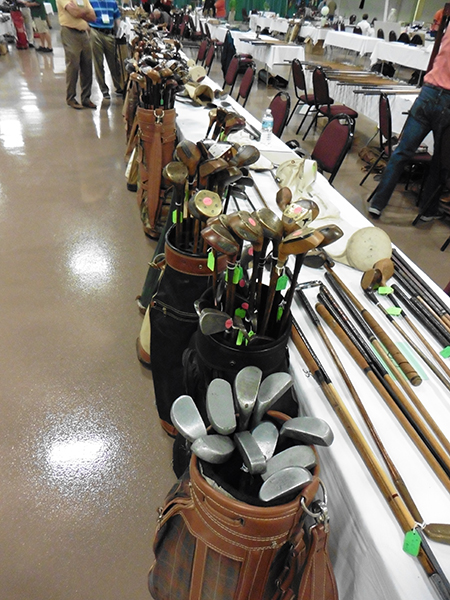Starting a Collection
By George Petro
Most often the inspiration for an assembly of related items (any collection) is personal in nature, such as organizing photographs of one’s family or friends, grouping awards won, or saving items from places one has visited, all as personal remembrances.
In the golf realm this might mean saving logo balls, tees, or hats… or even your scorecard at a course you’ve played or a pin flag or entry ticket from when you attended the Masters Tournament or any autographs while you were there. If your grandfather played hickory golf, you might decide to display his clubs you found in the attic. Or you might admire an impersonal item for its artistic impact or special curiosity and proceed to add related items.
Collecting includes the search, the acquisition, the organization, and display of items that interest the collector. To a collector these processes are pleasurable and academically satisfying.
There are millions of people who have a penchant for collecting something and also millions of others who are golfers. So one might expect large numbers of self identified “golf collectors.” In fact, very few people recognize golf as a bona fide collecting category. Certainly there is virtually nothing that someone doesn’t collect, but collecting coins, stamps, bottles, sports cards, comic books, and Coca Cola, to name a few, are mainstream with widespread literature support and marketing pressures and informative price guides.
For example, if I said I collect coins such, as Lincoln head pennies, anyone could identify easily with my collection. But to say I collect GOLF is to be met with puzzlement. How do you collect “golf?” The concept is difficult to explain. It might be easier to break that down into identifiable sub-categories of golf-related memorabilia. These include:
Golf clubs, balls, bags, tees and scorecards, art, ceramics/glassware/statuary, books, club histories, magazines, programs, postcards, tickets and pin-flags, medals and trophies, autographs, toys, historic items and many others.

Consider the collector of old golf clubs, the one’s made of hickory shafts that pre-date 1935 or so. These have long interested collectors for a variety of reasons – rarity, maker, style or type of club, clubs with important patents, etc. One many might enjoy collecting a world-class assemblage of ultra-valuable “long-nose” woods made before 1880. One might enjoy collecting irons that are stamped on the back with names of all the U.S. Open winners, one might look for those made by a specific company, such as Spalding or the Bridgeport Gun Implement Co. (yes, there is, or was, such a company, and this is a desirable golf club collecting category). There are MANY other categories of golf club collecting, including the later steel-shafted clubs in their many dozens of models and important patents. Because the field is almost limitless so is your ability to acquire expertise and construct a unique and potentially important collection to show or even write about. You will learn to focus on a specific niche within the near-infinite galaxy of golf clubs. Collection preferences are often fluid as knowledge and circumstances evolve.
Collectors can be “generalists” using broad inclusion criteria. They may acquire large numbers of items that provide numerous examples within many of the categories, and/or choose to acquire pieces of very high quality or rarity with just a few premier pieces in as many categories as desired. Also, the collecting urge is often to be a “completionist,” common with baseball cards, coins and stamps where completing sets within set parameters, may be a key feature. Completionists who primarily focus on their favorite golf sub-topic, can create collections that not infrequently rival or exceed the quality of top museums in those areas. Every item presents opportunities for the collector to dig in and discover something not found in any book and become a true world expert.
The GOLF HERITAGE SOCIETY provides resources and contacts that scientifically and socially enhance the enjoyment of a relaxing and pleasant hobby or even help to advance your collecting to a level where it becomes a “part” of your identity and purpose.
Let this introduction encourage you to the review the detailed reports within each category where you might decide how, what, and where to collect “GOLF.”
